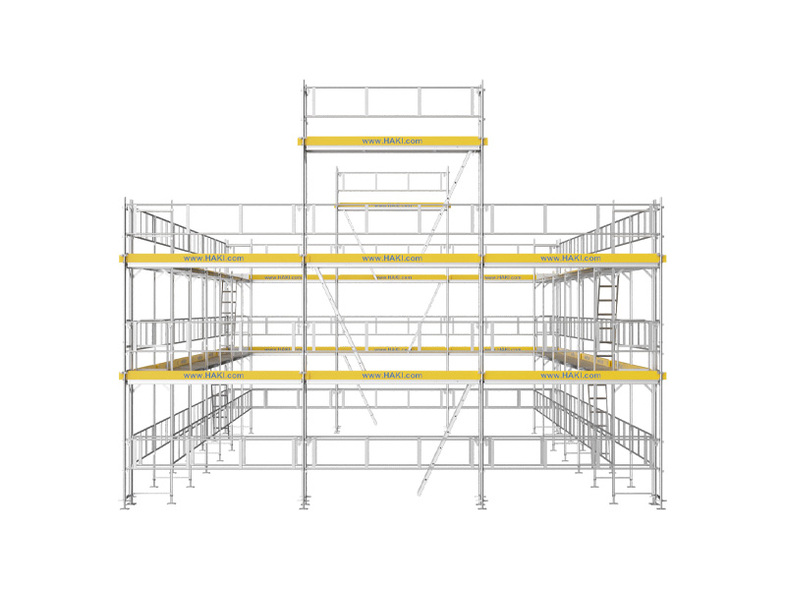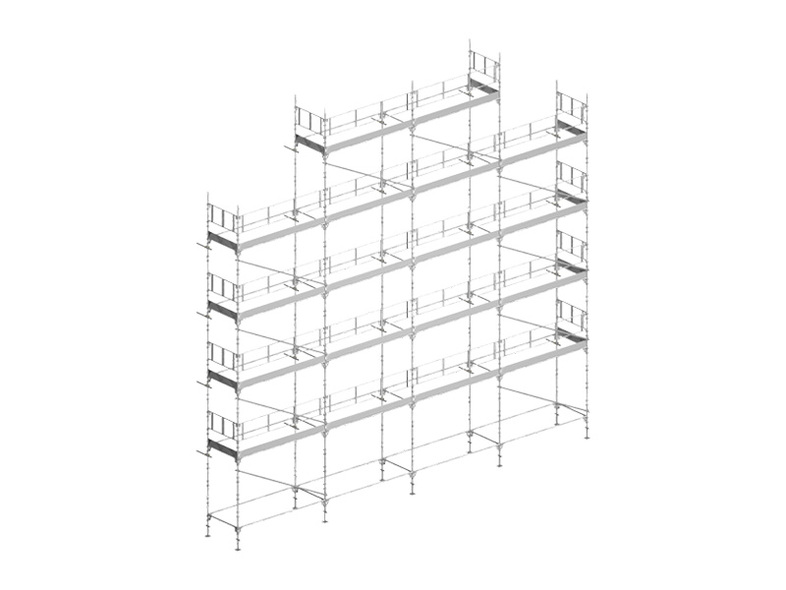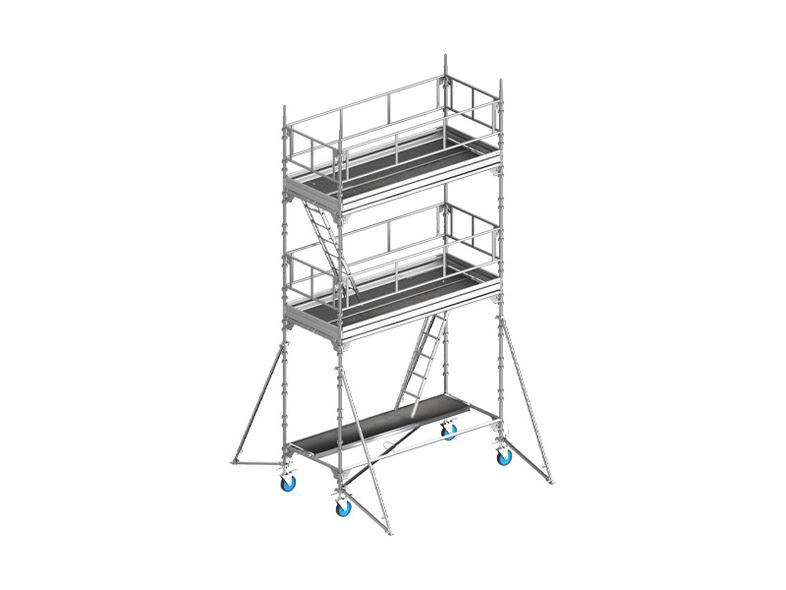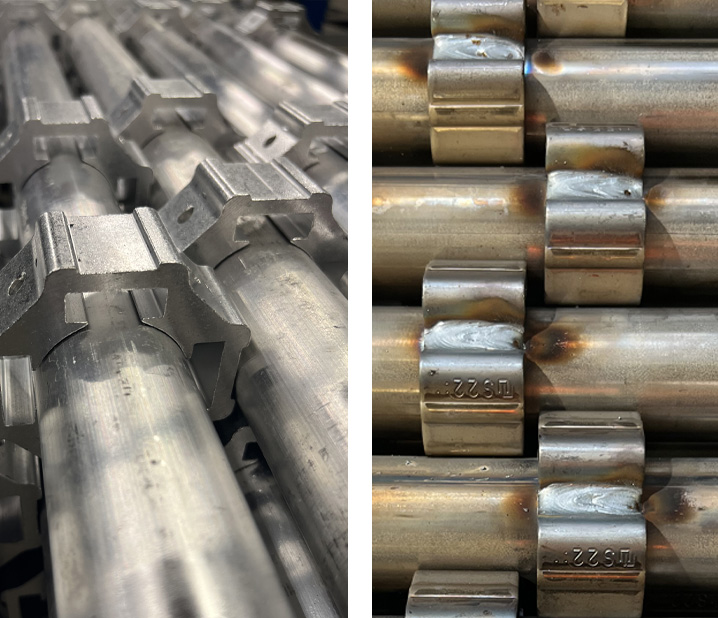Scaffolding Guide
Buying scaffolding is a big investment. That's why we've put together a scaffolding guide to make it easier for you as a buyer or user to choose scaffolding. We guide you through what you need to keep in mind when choosing a scaffold, what types of scaffolding there are, differences between materials, about dimensions and safety.
Choosing scaffolding
There are a few things to keep in mind when choosing a scaffold for your house construction, façade painting or renovation. This is to get the best conditions for working as efficiently and smoothly as possible, but above all to carry out the work in a safe way.
THE CHOICE OF SCAFFOLDING DEPENDS ON:
- Whether you are going to work outdoors or indoors
- How large your work area is
- If special solutions are needed to assemble the scaffold
- How heavy a load the scaffold should be able to handle
- How bulky material to use on the scaffold
- If there are one or more people working at the same time on the work platform
- If it is a private person or contractor who is to assemble and use the scaffolding
Which types of scaffolding are there?
The most common system scaffolding available on the market is frame scaffolding, modular scaffolding and mobile scaffolding. They are suitable for anyone who needs to be able to build scaffolding of different heights and lengths, indoors and outdoors.
Frame Scaffold
Frame scaffolds are quick and safe façade scaffolding with few basic components and simple constructions.
The simple constructions with closed frames are ideal for simple work on buildings with plain façade surfaces. Since the frames are fixed constructions with, among other things, integrated standards that cannot be adjusted, they are well suited when working on simple facades with straight angles.
A section of HAKI's aluminium frame scaffolding consists of only two frames, two guardrail frames and a deck unit where you simply hook the components. The stable guardrail frames do not require a diagonal brace. Fewer components make handling easier, and thanks to our patented spring locking catch, there is no need for tools to assemble and disassemble.
Our frame scaffolding HAKI Frame can handle a widespread load of 200 kg/m², have a width of 700 mm, and are therefore suitable for loads that are not particularly heavy or bulky on the work platform.
The frame scaffolding can also be easily built upon as needed, both in height and length, with additional work platforms and stair towers.

Frame Scaffolding - Summary
- For outdoor projects
- Extendable in height and length
- For simple work
- Plain façades with straight angles
- For relatively light and non-bulky materials
- One person at the time on the work platform
Modular Scaffold
The modular scaffolding is the most common scaffolding and has the advantage that it is very versatile and can be used for all types of work.
It is a durable and flexible scaffolding in steel and has a high stability. The modular scaffolding can handle a widespread load of up to 600 kg/m² and has a width of 700-1655 mm, which makes it suitable for working with heavy and bulky materials as well as allowing several people at the same time on the work platform.
Among other things, the standards and horizontal braces make it possible to create an almost infinite number of different structures. This means that the scaffolding can easily be adapted in height, width and to different angles, for example at doors and balconies, and installed around the entire façade.
Thanks to our patented spring locking catch, you completely avoid the use of tools during assembly and disassembly.

Modular Scaffolding - Summary
- For outdoor projects
- Extendable in height and length
- For complicated jobs
- For facades that require special solutions
- For heavy and bulky material
- Several people at the same time on the work platform
Mobile Scaffold
A mobile scaffold is a movable aluminium scaffold with adjustable castor wheels and outrigger stabiliser. This type of construction is suitable for simpler work indoors as well as outdoors on flat, smooth and hard surfaces. Many people use a mobile scaffold where space is tight and flexibility is needed.
A mobile scaffold is particularly suitable if you have work where you need to move the scaffold gradually during the work, or if you are going to carry out short-term work, where you do not have to carry heavy material up and down. The mobile scaffold has lockable castor wheels that make it easy to move, and is the optimal solution if you work alone.
No extra tools are needed to assemble a mobile scaffold, which makes it quick to install and easy to use. It is a solid construction but weighs relatively little as it is made of aluminum. Our mobile scaffolds can handle a widespread load of up to 200 kg/m² and have a width of 1250 mm. The mobile scaffold can be built up to 8 meters outdoors and 12 meters indoors, but it is important to keep in mind that you can only work on and load one platform at a time.

Mobile Scaffolding - Summary
- For indoor and some outdoor projects
- Buildable in height
- For small and straightforward work
- For short-term work
- For light materials
- One person and load on one work platform at a time
Material
Steel or aluminium scaffolding?
Scaffolds are available in steel and aluminium and both materials are equally safe and durable if handled correctly.
However, there are several advantages to aluminium scaffolding. They have significantly less weight and are therefore easier to assemble, disassemble and transport, which provides a gentler working environment. Therefore, they are ideal for short-term projects and when you need to assemble the scaffolding many times in a short period of time. Another advantage is that aluminium corrodes slower than steel and is preferable in humid environments.
A scaffold in hot-dip galvanized steel has a significantly more favourable price compared to one in aluminium but is on the other hand about 50% heavier. However, it may be better suited for long-term projects where you do not need to move the scaffolding as often.

Dimensions
What is length, working height and width of a scaffold?
How large a scaffold you need depends on how large your work surface is and how high and wide you need to reach. If you are going to carry out roof work, such as installing solar panels, the scaffolding should be high enough to reach the roof safely and smoothly from the top platform level. If you are going to carry out façade work, such as painting the house, it is optimal that the top platform is about 1.5–2.0 meters below the level where you need to reach.
Working height means the height of the scaffolding and an additional 1.5–2.0 metres above the top platform, depending on how high the adjustable base jacks are adjusted (maximum 0.5m). We calculate the working height as 2 meters including the maximum upward adjustment of the base jacks.
The dimensions of our scaffolds cover the work area and are indicated in length x working height. For our frame scaffolding, the working height includes the maximum up-adjusted base jacks, and for modular scaffolding, the dimensions are given in length x working height excluding up-adjusted base jacks.
The length refers to the long side of the scaffold and the width/depth refers to the short side. One section is stated as 3 meters long but is in reality 3.05 meters for our systems. The width of our frame scaffolding is 700mm and 700-1655mm for our modular scaffolding.

Safety
What do you need to consider when building scaffolding?
A scaffold that is to be used by private individuals can be erected without special authorisation, but if it is to be used as a workplace for contractors, it must be erected by a person with a scaffolding certificate and inspected by the responsible installer. It is also important to keep in mind that supplementation with stair towers is required for professional use of the scaffolding according to AFS 2013:4.
When installing a scaffold, it should be placed as close to the façade as possible, no more than 30 cm from the façade wall, which is the maximum distance without inner railings. To ensure that the scaffolding is as stable as possible, it is important that it is built on a surface that can withstand the total load from the scaffolding as well as the weight placed on it.
User manuals should always be used before starting the assembly of a scaffold! Download the latest versions here:


